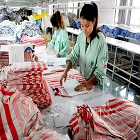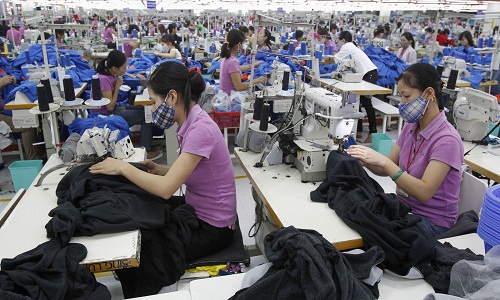FW
"CENTRESTAGE Elites, a spectacular fashion exhibition at the got going CENTRASTAGE debuted at the Hong Kong Convention and Exhibition Centre, Hong Kong. The exhibition is showcases the latest collections (Spring/Summer 2017) of four top designers from Asia viz. Hong Kong’s Mim Mak, Simon Gao from Beijing, Ko Taeyong from Seoul and Pongsak Suprratccheep & Thita Kamonnetsawat from Bangkok."

CENTRESTAGE Elites, a spectacular fashion exhibition at the got going CENTRASTAGE debuted at the Hong Kong Convention and Exhibition Centre, Hong Kong. The exhibition is showcases the latest collections (Spring/Summer 2017) of four top designers from Asia viz. Hong Kong’s Mim Mak, Simon Gao from Beijing, Ko Taeyong from Seoul and Pongsak Suprratccheep & Thita Kamonnetsawat from Bangkok. The gala event put the spotlight on CENTRESTAGE which is on till September 10. The gala fashion show aims to further reinforce Hong Kong’s position as an international fashion capital.
Top Asian designers set the stage

Top models including Zelia Zhong, Angie Ng and Kiki Kang walked the ramp at CENTRESTAGE Elites. A rising star on the Hong Kong fashion scene, Mim Mak was adjudged the winner of the Party & Eveningwear and the overall categories at the Hong Kong Young Fashion Designers' Contest 2012 (YDC). Mim Mak, a majore in graphic design major is best known for combining asymmetrical shapes and contrasting colours into classic tailoring, straddling the line between the fashion-forward and the practical. Bejing designer Simon Gao from Beijing is among the hottest fashion designers from Mainland China. Gao launched his eponymous label in 2012, and has exhibited at a number of major fashion weeks around the world. His works exude modern glamour that befits the personality of the strong modern woman.
As the youngest designer to take part in Seoul Fashion Week, Korea’s Ko Taeyong has earned the Korea Fashion Brand Award and Seoul Top 10 Designer Awards. His collection, beyond closet, is an amalgamation of youthful exuberance with bold contemporary flair and tradition. Thai husband and wife team Pongsak Suprratccheep and Thita Kamonnetsawat are brains behind popular Thai fashion label, Rotsaniyom White Label. The design philosophy focuses on delicate state of emotion and vulnerability, while retaining the casual ease of ready-to-wear. By combining delicate lace designs with intricate stitching and needlework with loose-fitting tailoring, the designers create collections of beautifully flowing forms.
Organised by the Hong Kong Trade Development Council (HKTDC), the trade show features around 200 fashion brands from 20 countries as well as more than 50 spectacular events, including around 30 other fashion shows. Designer sharing sessions, industry seminars, networking events and other activities have also been arranged in the fair period.
"Hiromichi Ochiai, the Designer and brain behind hot Japanese fashion label Facetasm, will be the VIP judge for ‘The Hong Kong Young Fashion Designers' Contest (YDC) 2016, to be held on September 10. Seventeen YDC finalists will take the stage to compete for the top three awards. The contest will be the finale of CENTRESTAGE currently on in Hong Kong. Ochiai will also share his insights with the finalists."

Hiromichi Ochiai, the Designer and brain behind hot Japanese fashion label Facetasm, will be the VIP judge for ‘The Hong Kong Young Fashion Designers' Contest (YDC) 2016, to be held on September 10. Seventeen YDC finalists will take the stage to compete for the top three awards. The contest will be the finale of CENTRESTAGE currently on in Hong Kong. Ochiai will also share his insights with the finalists.

Ochiai, was the first Japanese designer to reach the finals of LVMH Prize. He launched his own label, Facetasm, in 2007 and held the brand’s first fashion show four years later. At the 31st Mainichi Fashion Grand Prix in 2013, Ochiai received the Shiseido Award for best new designer of the year. Last year, he presented his 2016 Spring/Summer collection at Georgio Armani’s Armani/ Teatro at the Milan Fashion Week. The name Facetasm is derived from the word ‘facet’, implying each piece has different sides or different meanings.
Besides Ochiai, other senior industry and media representatives will be a part of the judging panel. Lawrence Leung, Chairman of HKTDC Garment Advisory Committee, will be the Chief Judge. Other judges include: Federico Tan, Director, social/capital; Bonnie Lam, Vice President, YOHO! Media Division; Reeds Yau, Director, Creative & Visual Merchandising, ImagineX Group; Jonathan Lee, Senior Buyer, Shine Trading (HK) Ltd; and Virginia Chan, Head of Footwear, i.t apparels Ltd. They will select the best works based on creativity and originality, market potential, workmanship, use of fabrics and overall visual appeal.
"Tirupur is all set to become the next China, pushing India ahead as global leader in apparel. With cost of production going up radically in China, it is phasing out textile and it seems the opportunity is for India to grab. Tirupur, often termed as the knitwear capital of India, is playing a crucial role in placing India in the top slot of global rankings."

Tirupur is all set to become the next China, pushing India ahead as global leader in apparel. With cost of production going up radically in China, it is phasing out textile and it seems the opportunity is for India to grab. Tirupur, often termed as the knitwear capital of India, is playing a crucial role in placing India in the top slot of global rankings.

India’s $17 billion exports of apparel were about half as much as Bangladesh’s last year and its 3.7 per cent global market share lagged behind Vietnam’s 5.1 per cent. Closing the gap is crucial: Apparel is a labor-intensive industry, which has historically helped developing economies transition out of agriculture. The Indian economy needs to generate 80 million new jobs by 2025 to keep up with its fast growing young population.
A dream fuelled by the Prime Minister’s vision
The general sentiments, is that Prime Minister Narendra Modi led government’s biggest failure so far has been inability to boost employment, which is now a major agenda for Opposition. To boost the apparel and textiles recently a nearly $1 billion package including subsidies for employment generation, tax refunds and relaxation of overtime rules with a goal to create 10 million jobs and boost exports by $30 billion in the next three years were announced.
Numerous challenges bog down industry
In its journey to the top, India has to tackle a few key challenges including worker productivity, which is almost three times lower than in China. One of the major reason for this is the unorganized nature of Indian apparel manufacturing which is dominated by unregistered units, limiting the use of modern production technologies and the capacity to take on large orders. It is becoming more challenging as foreign garment and textile producers prefer to embrace end to end automation. Experts say, India needs to start climbing the ladder fast to take advantage of its young population.
As per market reports about 78 per cent of Indian companies employ less than 50 workers, compared with 15 per cent in China and a lot of them remain below the threshold of government taxes and regulation, known by economists as the "informal" economy. The recently World Bank report shows that Bangladesh had 15 times more garment workers formally employed than in the informal sector, while India has about seven times more informal garment workers than formal.
Moreover focus on cotton has put a limitation on India’s apparel industry to access to the growing high fashion winter wear market. In neighboring Bangladesh, garments account for 80 per cent of overseas shipments, the monthly minimum wage is about 30 per cent lower than India’s $105, and exporters don’t pay duties to the European Union. It becomes difficult for Indian companies to compete, despite India’s large cotton production. The industry is surviving on government incentives that help businesses stay profitable and continue hiring.
Associations campaign for Tirupur like clusters
Now, Tiruppur exporters have also come together to lower costs by educating companies on effective low cost production management techniques and training staff to increase output. With government’s help the group hopes to take its action plan to the capital, 1,500 miles north. With an eye at top rankings India’s apparel manufacturers association is working together to reduce costs of operation, increase output and campaigning for creating more clusters like Tirupur.
PCI Wood Mackenzie will host World Fibres Conference in Hong Kong on November 9-10. Delegates will learn about the latest developments in raw materials, fibres and textiles and receive strategic insight on the forces influencing these complex, inter-dependent sectors.
The keynote speaker would be Rajen Udeshi, President, Polyester Chain, Reliance Industries. He will provide an executive overview of the sector. Other speakers lined up are: Alasdair Carmichael and Bruna Angel (both PCI Wood Mackenzie). Incidentally, the company will present the global fibres outlook.
Carmichael will discuss how global economic and social trends will affect the fibres mix, including how the locations of manufacturing supply chains and the production technologies used by the industry are shaping growth. Industry leaders will dwell on topics from sustainability, international trade dynamics and how geography affects competitive advantage, to changes in consumer health, lifestyle and demographics.
Analysts will shed light on how volume demand for key fibre types, and explore the specific needs of each market segment, with particular focus on how this will affect the raw material and fibre chains for polyester, nylon, cotton and viscose. To put discussions in context, the program includes a review of the global economy and outlook for oil prices, drawing on Wood Mackenzie's upstream research.h
With sales of its jeans picking up, VF Corp is repositioning both Lee and Wrangler jeans with new fall marketing campaigns. This is seen as a kind of drumming up some new advertisements for its denim brands. While still hanging on to old ads that feature heroes of a certain era including football players like Brett Favre, country legend George Strait and Nascar’s Dale Earnhardt, Jr., as well as its lineup of rodeo stars, Wrangler is making a play for a younger audience. Now, the NC-based company is switching to what it calls ‘a more emotionally based lifestyle marketing this fall’.
Instead of stressing the brand’s hard-working denim heritage, the brand’s new national TV ads are seen underscoring the famous W at play including camping, motorcycling and pool tables. Set to Howling Tongues’ fresh take on Credence Clearwater Revival’s Up Around The Bend, spots inform viewers to Be true. Be bold. Be yourself, Be comfortable in your own jeans. VF’s Lee brand is also getting into some new moves with a #MoveYourLee campaign from GSD&M. The new campaign goes for laughs, spoofing the superpowers of the Lee Man and the Lee Woman. A social-media focus encourages fans to upload their best 10-second dance videos tagged #MoveYourLee on Instagram for a chance to win prizes. The Lee effort stars the flexibility of jeans infused with spandex and other stretchy fibers, which VF hopes can give denim a leg up in the battle against yoga pants.
It has been recently reported that denim sales are up after a long slump sparked by the athleisure trends with sales climbing 2 per cent to nearly $13 billion in the 12-month period ending in June. And women, who buy about 60 per cent of all jeans, bought 304 million pairs. In its most recent quarterly results, VF’s sales of jeans wear rose 3 per cent to $629 million with Wrangler notching a 2 per cent gain and sales of Lee rising 8 per cent.
H&M is hoping for a breakthrough in textile recycling.
While it’s currently possible to mechanically recycle single fiber fabrics such as denim jeans and wool sweaters, a lot of garments are made from a blend of different fibers. A pair of women’s jeans might be made from a blend comprising 94 per cent cotton, five per cent polyester and one per cent elastane.
When these garments reach the end of their lives, they usually end up discarded in landfills or down cycled into low-value applications like insulation or carpeting.
H&M is trying to develop the required technology to recycle blended textiles into new fabrics and yarns. The aim is to create at least one ready technology to recycle clothes made from textile blends into new clothes. This would be a major breakthrough in the journey towards a closed loop for textiles in the fashion industry.
The Swedish retailer has for long been committed to collecting used clothes in stores in an effort to keep them out of landfills and give them a second life.
More than 12,000 tons of garments were collected in H&M stores in 2015—that’s as much fabric as in more than 60 million T-shirts—and more than one million products introduced last year were made with at least 20 per cent recycled material from collected garments.
The 64th edition of the London Fashion Week (LFW), to be held from September 16-20, will welcome over 5,000 guests from 58 countries. The organizers believe this shows London and the UK is a major player on the global stage. Figures, released in June this year, show that the British Fashion Industry’s worth to the British economy has increased 8 per cent from £26 billion to £28 billion. This growth is greater than that of the UK GDP which grew by only 5 per cent in the same period. On the other hand, employment has increased from 790,000 to 880,000, double the national average with growth in retail, manufacturing and wholesale.
This edition of LFW will feature 83 designers showcasing S/S ’17 collections and over 150 in the designer showrooms at Brewer Street Car Park. This season, LFW welcomes back international brands MM6 and Versus. Sharon Wauchob will be joining the schedule for the first time while Huishan Zhang, Molly Goddard and Teatum Jones will all be showing catwalks for the first time. Designers showcasing their designs with presentations for the first time include: Aquascutum, Globe-Trotter, Malone Souliers, Paula Knorr, Piers Atkinson and Roberts|Wood.
For years, LFW has embraced the changes in the fashion industry. This season, Burberry will be presenting its menswear and women’s wear collections together for the first time and will be immediately available to buy. Oliver Spencer will be showing a menswear consumer event at LFW and Kent & Curwen will be doing menswear appointments.
Japan-based Shima Seiki has launched its website ‘Shima Trend Archive & Forecast (staf®)’. This is a web-based service dedicated to empower its members with the means to search and download from a rich stock of information as well as tools to organize that information to aid in fashion planning, design and presentation.
The fashion industry has been regularly making people in the industry aware of the things going around. With this endeavour, industry regularly, fashion planners, designers and merchandisers have come under tremendous pressure to present new ideas on a regular basis leading to stress, psychological burn-out and even physical illness.
As a means to lighten this situation and give industry professionals an opportunity to enhance their planning efficiency and capability, staf® features an information archive of fashion and color trends covering the past 50 years in addition to those for the next season, as well as a massive collection of fashion-related content, covering materials, flat sketches and design patterns.
In addition, a vast collection of fashion photos are available in conjunction with the Aflo photo agency, and the latest fashion-related news articles can be picked up from news sites as well. All this information can be selected and sorted efficiently and organized in a concept board that can be shared among a variety of smart devices for presentation purposes.
Furthermore, the advantages of using staf® can be enhanced significantly in combination with Shima Seiki’S own SDS-ONE APEX3 design system. staf® content can be imported, edited and processed quickly and easily on APEX3. 3D data can also be combined with APEX3’s simulation capability, offering even more powerful and effective presentation.
Shima Seiki will feature staf® at the upcoming Première Vision show in Paris this month (September 13- 15) at Parc des Expositions de Paris Nord Villepinte). Enthusiasts are waiting to have a look at the web service that has a 30-day free trial on registration.
Cotton produced by forced labor, documented in at least nine countries, makes its way into clothing and home goods sold by major brands and retailers. It is an open secret that the garment and textile supply chain is rife with forced labor and other human rights abuses.
The Responsible Sourcing Network has launched an initiative to eradicate modern slavery in cotton harvesting and yarn production by enabling yarn spinners to identify and eliminate cotton produced with forced labor. The initiative has received the support of brands and retailers such as Adidas, Hudson’s Bay Co, and Woolworths Holdings, which have acknowledged that it is important for companies to work together to create and advance an international ethical and sustainable cotton value chain.
This program will pilot in India and Bangladesh, which have numerous spinning mills and are highly affected by forced labor. It identifies a gap in transparency between where forced labor occurs in the cotton fields and the facilities in which different cottons are blended together. The aim is to close this gap by focusing on yarn spinning mills in the supply chain and establishing a training, assessment, and verification process. Identifying and addressing the forced and bonded labor of young women in spinning mills in southern India will also be incorporated into this initiative.
With both sides offering to lower or eliminate tariffs on a number of items, India and Chile have agreed to broaden their bilateral preferential trade agreement (PTA). The agreement was signed by Commerce Secretary, Rita Teaotia and the South American country's Ambassador to India, Andres Barbe Gonzalez.
"Under the new PTA, Chile has offered concessions to India on 1,798 tariff lines with margin of preference (MoP) ranging from 30 per cent to 100 per cent. On the other hand, India has offered concessions on 1,031 tariff lines at 8-digit level with MoP ranging from 10 per cent to 100 per cent to Chile," said a Commerce Ministry statement.
Signed in March 2006, and effective since August 2007, the original PTA had India offering 178 tariff lines to Chile, with the margin of preference ranging from 10 per cent to 50 per cent. Meanwhile, Chile offered 296 tariff lines to India with MoP ranging from 10 per cent to 100 per cent. India's bilateral trade with Chile stood at $2.64 billion in 2015-16, making it India's third largest trading partner among the Latin American and Caribbean Nations (LAC) grouping. "India's export basket with Chile is diversified and keeping in view the wide variety of tariff lines offered by Chile, the expanded PTA would immensely benefit India," the statement added. Exports to Chile include transport equipment, drugs and pharmaceuticals, yarn of polyester fibres and tyres and tubes, among others.












